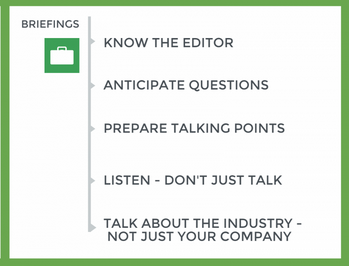5 Tips for a Killer Briefing

Media are always looking for experts in their beat to interview so they can add expert industry commentary and more depth to their articles. Briefings can also be incredibly useful for a company. It is a great way to generate company awareness, as long as the company representative is well-prepared and knows how to deliver a successful briefing.
Below are five tips I’ve learned working with our clients that ensure you have a killer briefing.
1. Know the editor: A big part of what makes a media briefing successful actually happens before the interview even takes place. It’s important to do your homework ahead of time. This means reviewing what focus areas the editor specializes in – topics they cover, interests, past positions, the editor’s key audiences and recent articles. Being able to reference a recent article shows you have put effort and value into the briefing. Everyone loves a little recognition every now and then, so this would be a great way to get the briefing started off on the right foot.
2. Anticipate the questions that will be asked: Is this a briefing based off of a recent company announcement? Is this is a briefing on a response to a particular trend or are you serving as a resource for the editor? No matter what type of briefing you have garnered with an editor, it’s important to anticipate questions that might be asked so you can have a prepared response rather than thinking on the fly. For example, say you just released a company launch announcement, the editor will most likely ask about funding, investors, customers, etc. These can often be sensitive questions, so anticipating these ahead of time will help you from disclosing information that is not public.
3. Prepare talking points: A typical briefing is 30 minutes, so with a limited amount of time, it’s important to give clear and concise answers. If there are specific topics you know you want to bring up or a customer example to highlight, preparing a list of talking points ahead of time will help you stay on track. It’s often easy to get sidetracked in the conversation, but creating an internal checklist will help ensure you accomplish all of the points you want addressed in the briefing.

4. Listen – don’t just talk: Each editor is different and will have a different way of reporting on the industry or news. Briefings
should be an interactive, two-way conversation rather than you just spilling as much information about your company in 30 minutes as you can. Instead, focus on what the editor wants. Listen for the editor’s story angle and point of view on the topic and match your answers to address those. Also, listening and letting them chime in with questions and comments throughout the briefing is key to an engaging conversation. The goal is to build long-term relationships so that editors come back to you as an expert resource in the future.
5. Talk about challenges in the industry, not just you: While briefings are an excellent resource to raise awareness of your company within the industry, this is not a free pass to just talk about your company and how great you are. Not only are editors obligated to be vendor-neutral, but no editor is going to write about you without including context of the industry and possibly your competitors. The best way to set yourself apart and really sell your company is by addressing the challenges in the industry and how your company is working to solve them. Positioning yourself as a forward-thinking and a community-player to better the industry will go a long way.
